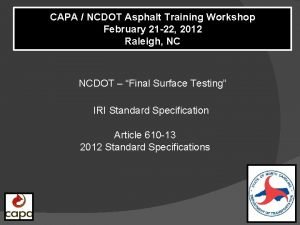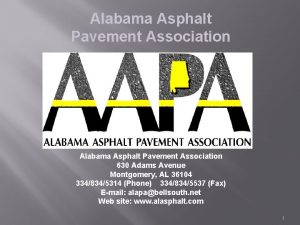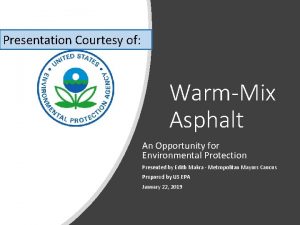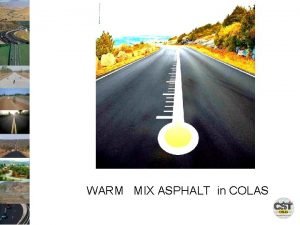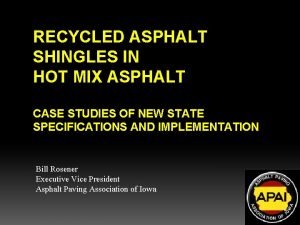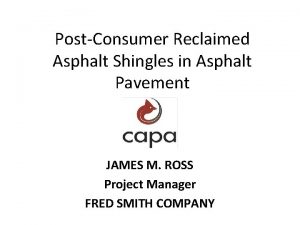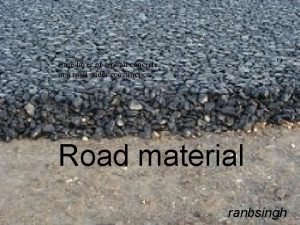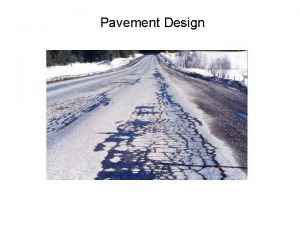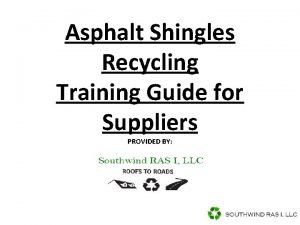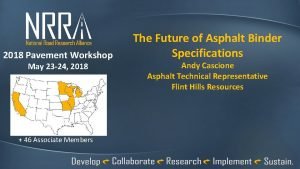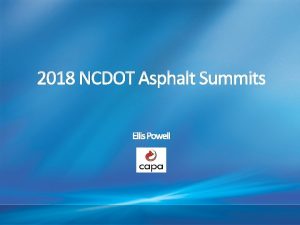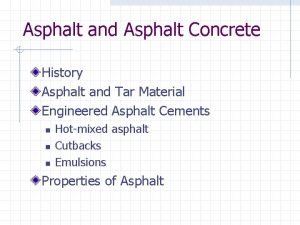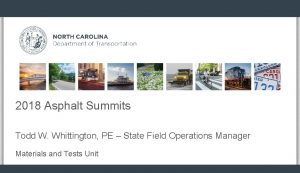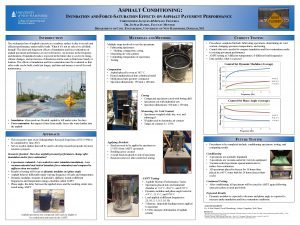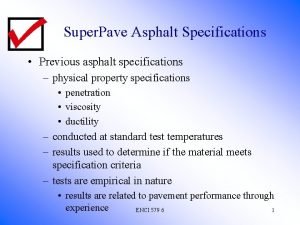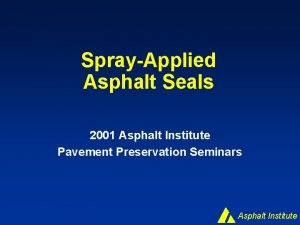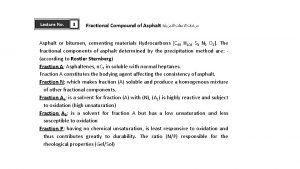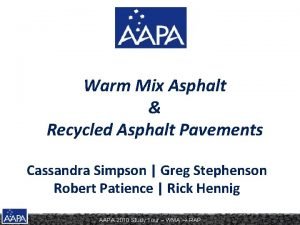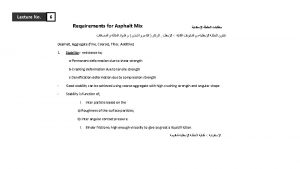2018 NCDOT Asphalt Summits Ellis Powell Upcoming Work






















- Slides: 22

2018 NCDOT Asphalt Summits Ellis Powell

Upcoming Work Completing on Time Upcoming work – resurfacing, TIP, preservation – and proposed ad and let dates Resurfacing and Preservation Let lists – keep up to date Resurfacing Project Completion data and ideas to improve Pavement Marking – LD’s, capacity, paint on most NC and SR roads for resurfacing projects, long life marking by other contracts

Completing on Time Problem resolution - early and often communication - escalation process with timeframes Importance of good and timely decisions - Completion record – we all share this record - Future funding - Impact on other projects

Working Together Levels of Experience - Teamwork - Learning from each other - If you don’t know find out – don’t just say no Use of CEI - Increasing – not going away Number of CEI inspectors on projects Keeping up with the cost Previous NCDOT Experience?

Intent and Flexibility Holiday Time Restrictions - intent - all holidays the same? - all routes the same? Lane Closure Time Restrictions - staging vs lane closure - if traffic allows get to work Working During Seasonal Limitations - Contractors - communicate the desire early - NCDOT - allow if weather permits

General Summit Topics Patching cost greater than or equal to 10% of estimate – major item – therefore subject to overrun/underrun Mill & Fill vs Patching and Overlay and Shoulder Work OGFC Tie-in at Bridges - One mix type going forward – FC-1 Modified Taper 50’ from the bridge - no milled butt joint Utility adjustments and rings Small Quantity Density Acceptance – testing turnaround time Timely Payment of Monthly Estimate How to investigate pavement concerns/issues - Don’t core first, you are making weak spot/pothole – observe, discuss - Get expert feedback – SPCE, ACE and Pavement Specialists

General Summit Topics Combining B&C mixes - Decreased rut criteria, increased ESALS New “B” on more routes Eliminated 70 -22 liquid One base and one intermediate Converting mixes - no new control strip Emulsion Review

What is an Asphalt Emulsion? o An asphalt emulsion is performance grade asphalt suspended in water using acid and surfactant. o Emulsion is made from varying types of performance grade asphalts. o Emulsion is used in many highway maintenance applications.

How Is An Emulsion Made? o Asphalt, water, acid and a surfactant are combined using a colloid mill. o All of these ingredients are combined into micron sized particles and the finished product, asphalt emulsion, is then pumped out to storage tanks.

Types of Emulsion Type o o Use CRS-1 Tack Coat CRS-1 H Tack Coat CRS-2 L Chip Seals HFMS-1 Tack Coat

Asphalt Emulsion Storage How Do You Store Your Emulsion?

Asphalt Emulsion Storage How Do You Store Your Emulsion?

Asphalt Emulsion Storage How Do You Store Your Emulsion?

Asphalt Emulsion Storage How Do You Store Your Emulsion?

Asphalt Emulsion Storage How Do You Store Your Emulsion?

Asphalt Emulsion Storage How Do You Store Your Emulsion?

Handling Emulsion o Do Not Heat And Cool Repeatedly. • Repeated heating and cooling can cause the material to fall out of suspension making the tack useless. • If you need 500 gallons to cover the flue for heating then only load 500 gallons. • Load the distributor with the day’s production in mind and reduce pumping left over material back into the holding tank. o Do Not Constantly Pump. • Repeated pumping will cause the emulsion to shear which creates small particles that will clog the nozzles.

Handling Emulsion Do Not Allow Emulsion to Freeze In The Tank • When an emulsion freezes the asphalt and water separate causing the material to break in the tank. Use Diesel Fuel Properly For Pump Cleanout • Be sure to use the Reclaimation Tank on the Distributor and remove all fuel prior to pumping into distributor • Diesel fuel introduced into the distributor will change the characteristics of the emulsion.

Handling Emulsion Do Not Add Water • Unless you are using an emulsion for prime on an aggregate base, applying a cure seal to CTA or fogsealing a shoulder or rumble strip you should never add water to an emulsion. . • By adding water to an emulsion that is used for tack you lower your residual asphalt content which can lead to bonding issues.

Contamination and Sampling Emulsions are chemical systems, they should never be mixed with other types of emulsions, they should never be mixed with other chemicals. Never mix emulsions from different producers. For emulsions cleanliness is very important. A sloppy operation will produce problems. When an emulsion comes in contact with air it can begin to break. Distributors and tankers should be clean and flushed between loads. New material should not be pumped in on top of old material, especially different grades. Diesel fuel is a common contaminant that is known to destabilize an emulsion. Emulsion Sampling – Follow AASHTO R 66, Before sampling contact M&T to be sure proper protocol is followed. Results indicating a failing sample may be false if protocol not followed; needlessly causing frustration, confusion and wasted time.

Pave After Emulsion Breaks Allow Time For Emulsion To Break Prior To Paving • The length of time depends upon environmental factors and application rate • When it is hot outside emulsion breaks quicker (few minutes) • When it is windy emulsion breaks quicker (few minutes) • When it’s cold outside emulsion breaks slower (several minutes) • When there is more moisture in the air emulsion breaks slower (several minutes) • Higher application rate- emulsion takes longer to break • When emulsion breaks it changes color from brown to black (as the water evaporates) • Paving before emulsion breaks can lead to bonding issues

Questions and Comments?
 Ncdot asphalt index
Ncdot asphalt index Summits on the air
Summits on the air сота кх
сота кх Ncdot fts
Ncdot fts Que letra continua m v t m j
Que letra continua m v t m j S&b asphalt
S&b asphalt Alabama asphalt pavement association
Alabama asphalt pavement association Warmmix
Warmmix Aashto flexible pavement design example
Aashto flexible pavement design example China nonionic asphalt emulsifier
China nonionic asphalt emulsifier Colas liquid asphalt
Colas liquid asphalt Determann asphalt
Determann asphalt Asphalt pavement design example
Asphalt pavement design example Bulldosing
Bulldosing Fred smith asphalt plant
Fred smith asphalt plant Standard axle load for pavement design
Standard axle load for pavement design Asphalt base layer
Asphalt base layer Asphalt concrete core embankment dam
Asphalt concrete core embankment dam Cbr method of pavement design
Cbr method of pavement design Shingle recycling near me
Shingle recycling near me Contained rock asphalt mat
Contained rock asphalt mat Faa p-401
Faa p-401 Nchrp 23-24
Nchrp 23-24
